Tag: Berkeley 150
Crip Camp and Judy Heumann: Studies in Movement Snapshots
by Annabelle Long
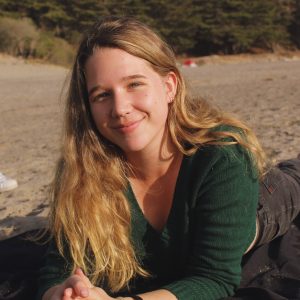
Annabelle Long is an Undergraduate Research Apprentice at the Oral History Center. She worked with Shanna Farrell during the Spring ’21 semester. Annabelle is a third-year History and Creative Writing student from Sacramento. She works as a conduct caseworker in the Student Advocate’s Office and enjoys going on long walks in Berkeley. You can find her on Twitter @annabelllekl.
I watched the 2020 documentary Crip Camp to get a sense of Judy Heumann, the disability rights icon and architect of a movement that created a more accessible world. I had only recently read her oral history, conducted by UC Berkeley’s Oral History Center, and I was eager to learn more about the woman behind the words on the page. When she is first shown in the film, she is doing what I’ve learned that she does best: leading a group. She has a big voice and a bigger grin, and talks campers through their options for dinner later in the week. She’s already thought it through—she considered veal parmesan, but found the veal to be too expensive, so next on her list is lasagna, the suggestion of which elicits both cheers and groans from the crowd. She offers everyone a chance to make their case, and then takes a vote. Lasagna wins—barely. This vote, in its consequences, probably meant very little to Judy and very little to everyone else. But in my mind, it makes one thing clear: Judy didn’t make any decisions without considering and consulting the group. She cared what people had to say, and she listened. And so campers had lasagna, and eventually, thanks to her activism, disabled Americans had laws to protect them.
Crimp Camp provides a snapshot of the disability rights movement through the lens of Camp Jened, a summer camp for disabled children and teenagers that opened in upstate New York in 1951. Each summer, about 120 campers moved in for four to eight weeks. The camp, despite often being credited with changing the lives of its campers, had immense financial struggles and closed its doors in 1977, leaving its legacy in the hands of the many campers who passed through. Judy contracted polio and became paralyzed at 18 months old, and for every summer from ages 9 to 18, she was one of those campers. She credited her time at Jened with shaping her approach to activism and life generally.
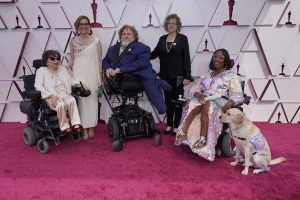
Jened resembles the woodsy summer camps of my childhood, but it had more of a Summer of Love aura about it—the rec room was boisterous and the softball games were passionately played, but at Jened, counselors were hippies, campers fell in love, and the bunkrooms and mess halls overflowed with eager conversations about the state of disability rights and the world. It was in those conversations, Judy would go on to say, that she learned to listen to a group, lead a group, and speak as a part of a group. To Judy and the other campers, Jened was more than a camp: it was a place to be fully and truly oneself, a place to try out new politics, and often, a place to meet close friends and lovers (Judy even said she never dated outside of camp). It almost seemed sacred.
Jened is both a moment and an enduring feature in the history of the disability rights movement, and Crip Camp seeks to understand it as both: as a physical place, where people gathered and grew, and as a concept, a memory and idea that endured well beyond the summers it operated. Oral history, as a practice, seeks to accomplish something similar. It draws on memories of particular moments, the feelings that make something worth remembering, and unites those memories with broader historical narratives to give a complete picture of a life and a time. But I can’t help but wonder—what does it mean when a story continues after the taping is done? When the end of the recorded narrative turns out to be the midpoint of a real and full life?
Judy Heumann’s oral history focuses on her time UC Berkeley, where she received her master’s in Public Health, and the 504 sit-in of 1977, which she was critical in organizing. For 25 days, Judy and well over 100 disabled people occupied the San Francisco office of the United States Department of Health, Education, and Welfare and demanded enforcement of Section 504 of the Rehabilitation Act of 1973, which stated that no institution receiving federal funding could exclude people on the basis of their disability. Judy’s activism in 1972 was critical to getting Section 504 written in the first place, and she and other disabled people were tired of it being completely unenforced—schools, cities, and buildings were still inaccessible despite the law’s promise. Schools lacked elevators to allow disabled students to get to their classrooms; sidewalks lacked defined dips in the corners and thus often forced wheelchair users to take inconvenient, circuitous routes to their destinations or left them stranded. In response, disabled people occupied government buildings across the country in protest. The San Francisco demonstration was the longest lasting and arguably the most successful, largely thanks to the motivating force that was Judy Heumann.
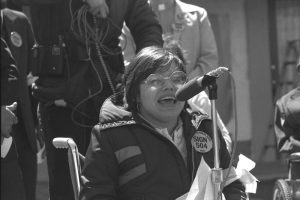
Judy Heumann
In Crip Camp, Corbett O’Toole, a disabled activist and one of Judy’s contemporaries at the Center for Independent Living at UC Berkeley, said that “we were more scared of disappointing Judy Heumann than we ever were of the FBI or police department arresting us.” This was because Judy served as the central organizing force of the occupation—she held down the fort, ensured people’s needs were met (no easy task when many occupiers required around-the-clock physical assistance), and negotiated with government figures to advance the cause. I’d be scared to disappoint her, too.
There’s no debate about her status as an organizing powerhouse. In the early days of the disability rights movement, everyone in her orbit seemed to recognize that she had a knack for getting people together, getting people to listen, and perhaps most crucially, getting people to act. Mary Lester, a staff member at the Center for Independent Living spoke about Judy in her own oral history and credited her with the movement’s expansion.
“Judy was the one who brought in deaf services and was the one who always wanted to expand the population we were serving. She was pushing us in those directions to broaden the coalition. She was a networker supreme,” she said, “Judy wanted to push CIL as far as it could go in terms of being a model and being a pioneer and bringing all of the different disability factions, if you will, together.”
Judy was meticulous and thoughtful in her activism; no stone went unturned, no idea went unexplored, and no voice went unheard.
“We had the civil rights aura, but we had the facts,” she said of the Independent Living Movement, which she helped develop in Berkeley, “I mean, I think the civil rights aura without the facts actually doesn’t get you where you need to be. But the facts without the civil rights perspective doesn’t necessarily get you there either.”
Berkeley, as a city and community center, played a critical role in shaping the 504 sit-ins and the disability rights movement more broadly.
“Well, you know Berkeley is a small community, period. And many of the people certainly at that time were activists. And you lived on the same block with somebody, or a couple of blocks away,” she said, starting to laugh, “And that’s just the way it is. It’s a town.”
UC Berkeley was to Judy and her friends what Jened had been to them in their youth. Crip Camp gets at this: many of Judy’s friends from her camp days eventually made the same westward journey that she did, and ended up in and around the UC Berkeley community. There, they took the community they’d built in upstate New York and turned to activism. Jened taught them the importance of their community; Berkeley taught them how to fight for it.
Judy Heumann recorded her oral history with UC Berkeley’s Oral History Center in 2007, decades after her time at Camp Jened and some of her most well-known organizing efforts. Since then, she’s lived nearly another decade and a half—enough time to feature in an Oscar-nominated documentary, host a podcast, produce a research paper on improving media representation of disabled people, publish a memoir, and work on advancing disability rights internationally as a special advisor to President Obama in the State Department.
She spoke about her international ambitions and hopes for the disability rights movement in her oral history, before Barack Obama was even the Democratic nominee for president; before there was even an inkling that her role as his special advisor on international disability rights would ever exist. In this way, oral history provides us with a window into her mind, a snapshot of a moment in the unfinished history of the disability rights movement. This, perhaps, is part of the value of an oral history conducted before the end of someone’s life—it reveals the in the moment motivations and thoughts behind future actions, and is definitionally more than just temporally distanced reflection or speculation about how and why something occurred.
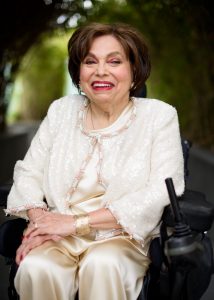
Judy Heumann at the 2021 Academy Awards
In the same way that Crip Camp sought to capture multiple dimensions of Camp Jened and its legacy, looking at Judy Heumann’s oral history in light of the more recent years of her life allows for a complex and interesting portrait of her and her accomplishments. As a history major, the people I study often never lived to see the worlds that they created, so it is especially wonderful to know that Judy Heumann saw the disability rights movement from its inception to a piece of storied history behind the world as we know it now.
“But you know, you walk up Telegraph Avenue, you go to Rasputin’s, and you see this history of the disability movement, and the owner of the store proudly displaying history of the disability rights movement on a building,” she said in her oral history, “You see, I go into a restaurant yesterday and there are two young disabled people coming in from Berkeley sitting down and having lunch together. The waiter’s moving the chairs out, and I’m like, oh, I guess two people in chairs are coming. And these things are natural now, because there is such a large number of people here that the community itself has become more accepting. It’s normal.”
I am a student at UC Berkeley and I live a block from Telegraph Avenue; between me and Judy’s tangible legacy sits a sidewalk that slopes down at the corners for wheelchair access. The world is not perfectly accessible, and there is still much to be done to ensure that disabled people’s rights are protected, but I like to think about how my normal is the product of Judy’s life’s work.
From the OHC Archives: Linda Perotti, Apolitical Advocate
By Annabelle Long

Annabelle Long is an Undergraduate Research Apprentice at the Oral History Center. She worked with Shanna Farrell during the Spring ’21 semester. Annabelle is a third-year History and Creative Writing student from Sacramento. She works as a conduct caseworker in the Student Advocate’s Office and enjoys going on long walks in Berkeley. You can find her on Twitter @annabelllekl.
Linda Perotti didn’t mean to join a movement. She arrived in Berkeley a year after the Free Speech Movement got its raucous start on the steps of Sproul Hall, the university’s now-famous administrative building on the southern edge of campus, and she was more concerned with keeping up with her coursework than with any of the growing number of antiwar and civil rights movements that would come to characterize Berkeley in the late 60s.
“[T]he thing I remember most is the Sproul steps, just sitting there and watching people go by,” she said of her freshman year. She regarded herself as an observer, never a participant. But as these things tend to happen, a movement found Linda anyway.
As a freshman at Cal, Linda was surrounded by the energy of the movements unfolding across campus. Sproul Plaza seemed perpetually occupied by someone giving an impassioned speech about any number of political issues to a crowd of eager students, her male friends constantly fretted about being drafted, and sometimes, police vans and teargas would descend on campus, their motivations largely unbeknownst to her. On any given day, her Sproul people-watching might have included a lecture on the value of political speech on college campuses, a demonstration against the Vietnam War, or a march down Telegraph Avenue, which led from campus into the city. UC Berkeley, to her, was a thrilling, semi-utopic reprieve from a culturally homogenous childhood spent in Michigan and the San Fernando Valley; a place where everyone and everything could be reached on foot; a place where she could be an individual; a place where everyone was intellectually serious, but no one took themselves too seriously.
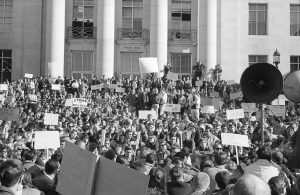
Sproul Plaza during the Free Speech Movement
Linda remained uninvolved in campus politics for her first two years at Cal, but that doesn’t mean she wasn’t paying attention to things happening around her.
“I remember one of the eeriest sights, when I really became aware of what a political hotbed Berkeley was,” she said of witnessing a stand-off outside her freshman dorm, just south of campus, “What turned out to be a SWAT team. They were all cops, just gathering, with shields and helmets and batons. I had never seen anything like that. It was extremely scary. Now if you saw that, you might just shrug and say, ‘Oh, something’s going on.’ But in 1965, it was a real phenomenon.” She didn’t have to be involved in a movement to understand that they were everywhere in Berkeley.
She moved to a new apartment on Ward Street at the beginning of the summer of ‘68—the summer of Robert Kennedy’s assassination, the Poor People’s Campaign, and Nixon’s nomination—and soon found herself spending a lot of time with the Roberts family, whose comings and goings via van and motorcycle she’d observed for weeks before discovering that one of the motorcyclists was her acquaintance, Mark Roberts. The small, green Roberts house was a peculiar one for a college town, and Linda was drawn to the fact that the Roberts family actually acted as a family unit. Linda had many friends, but they were just as independent as she; she didn’t yet have a family in Berkeley.
Zona Roberts and her sons were different. Zona zipped off to class on her motorcycle each morning, and there seemed to be a constant rotation of young people cycling in and out of the house.
“The whole family—they’re a very friendly family. Very, very friendly people. And just very unassuming. At the time, Zona was a student at Berkeley herself. Her husband had died a few years earlier. I don’t know how she did it financially. She was always on the edge, but somehow she managed,” Linda recalled.
She was attracted to the hum of energy radiating from the house and soon befriended Mark’s older brother Ed Roberts, the first wheelchair user admitted to UC Berkeley and the eventual father of the Disability Rights and Independent Living Movement. He suggested that she stop by Cowell Hospital and lend a hand. Cowell, while a fully functioning campus infirmary, also functioned as a dormitory of sorts for physically disabled students. It was unlike any program that existed anywhere else, and while Linda’s recollection of her early days there was hazy, she spent her summer on the northwest side of campus, doing odd jobs at Cowell.
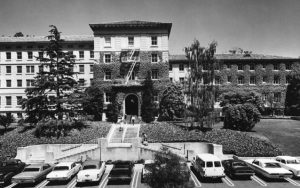
Cowell Hospital
As a woman, the help she could offer was limited—only men lived in Cowell at that point, and she recalled that “the men only had other young men working for them,” so she found herself doing laundry, typing up various documents, pushing wheelchair users around campus, and hauling enormous pots of chili and spaghetti across campus for Friday night dinners. Gender continued to define Linda’s relationship to Cowell and the budding Disability Rights Movement writ large; to her, the politics of the movement were for the boys.
“I never was interested in the political aspects of it,” she said, “It was just a byproduct as far as I was concerned. I even used to laugh at the guys. See, ‘the guys.’ It just happened to be that way.”
This disinterest was not from lack of care, but rather what Linda described as a naturally apolitical disposition. It wasn’t as if she wasn’t also interested in the pro-disability rights causes “the guys” were organizing for; of course she was. She spent her days working at Cowell and with the leaders of the Disability Rights Movement, albeit never in the context of their activism.
“This was really good for me,” she said of her proximity to their activism, “because it suited my level of political interest or awareness.” To Linda, her work was most significant when it was on the ground and person-to-person. Someone else could handle writing to the Chancellor.
“I had gone through the Cowell Hospital movement where people got organized and found their own strength and actually made their demands in such a way that the university responded to them and actually established a program just to serve the physically disabled,” she recalled, “That was very interesting.”
In the fall of 1968, the Cowell Program admitted its first female resident, and just as he had earlier in the summer, Ed Roberts encouraged Linda to go on up and introduce herself. Perhaps, Ed thought, Linda could serve as this new resident’s attendant, and help her with day-to-day tasks like bathing and getting dressed for class. Cathy Caulfield, Cowell’s first female resident, arrived in time for the fall semester, and sure enough, Linda became one of her attendants. At the same time, Linda recalled, the conversations that would serve as the foundation of the disability rights movement started picking up on the third floor of Cowell, where the program residents lived. Something was in the air.
But Linda was focused on her work. She had never been an attendant before, and the job was demanding. She deeply cared about being a good attendant for Cathy, and even beyond that, she cared about being a friend to her. So Cathy taught her how to change a urinary catheter, and how to dress and bathe her, and in turn, Linda learned how to be caring and gentle and composed. Her experience was typical; none of the attendants had formal training beyond what the people they worked for taught them. Cathy soon became deeply involved in the political organizing happening on the third floor, and she and Linda became good friends.

“I didn’t see myself as part of an attendant group because the rest were guys, and they worked for the guys, and my two friends and I worked for Cathy, ‘the woman,’” Linda said, referring to her two close friends who also worked as attendants. Her focus was Cathy, not finding community with other attendants or Cowell residents, and to her, that was just as well.
The next few years of Linda’s life track nicely alongside the development of the Disabled Students’ Program (DSP) and the Center for Independent Living (CIL)—she stopped taking classes during what would have been her senior year, and spent a lot of time with the organizers behind DSP and CIL as the programs swelled in size and scope. Still, though, movement politics were uninteresting to her. She cared about streamlining attendant referral services—everything was still word of mouth—and developing peer counseling services for disabled students, and helping the organizers accomplish other goals that they had, but she understood her role to be primarily administrative.
Linda Perotti never thought of herself as an activist. Her work was work, even if that work was also groundbreaking and life-changing and empowering for more people than she ever probably knew she could reach. The Sproul steps that she remembered so fondly have since witnessed many more movements, and many more generations of students who have benefitted from the activism—and semi-passive support—of Berkeley students that came before them. Linda may not have meant to join a movement, and maybe she would contend that she never actually did, but she certainly made a difference—for Cathy and the other Cowell residents, for herself, and for the generations of Berkeley students that followed her.